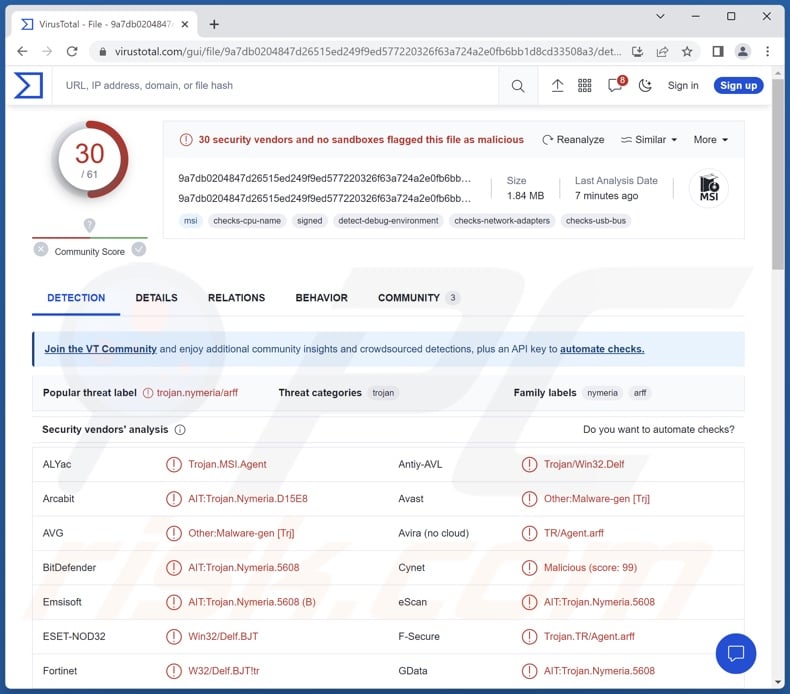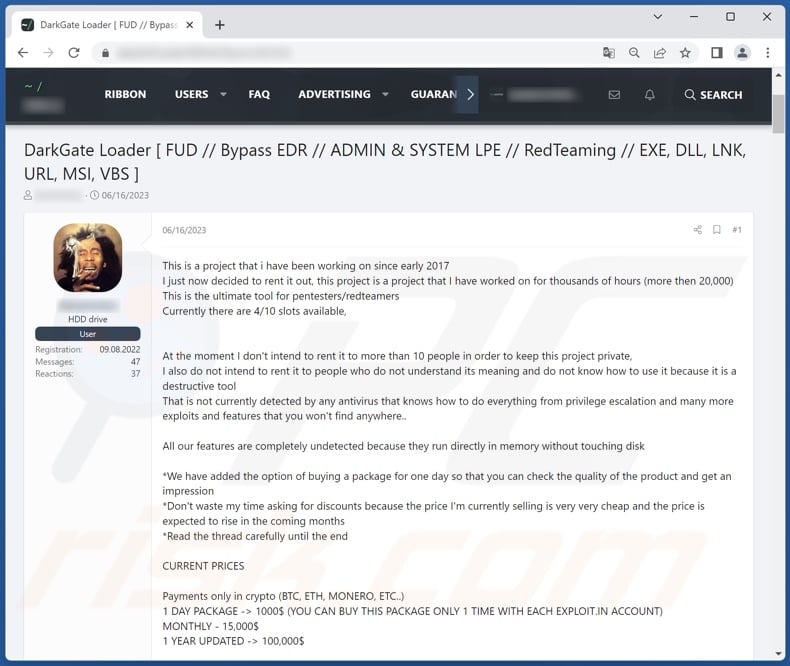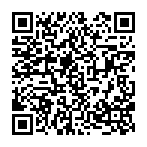How to remove the DarkGate malware from your operating system
![]() Written by Tomas Meskauskas on (updated)
Written by Tomas Meskauskas on (updated)
What kind of malware is DarkGate?
DarkGate is a versatile malware toolset. It has been around since at least 2018, with the newest variant emerging in July 2023. The older versions were heavily spread via spam mail and Torrent sites, the latter focusing on Europe, particularly Spanish-speaking users.
The latest DarkGate iteration has been observed being distributed utilizing malvertising (malicious advertising), search engine poisoning, and spam campaigns.

DarkGate malware overview
DarkGate boasts several anti-detection and anti-analysis mechanisms. It implements obfuscation, anti-VM capabilities (i.e., detection when launched on a virtual machine), and Microsoft Defender Antivirus detection exclusion. This malware is also hidden on Windows Task Manager, and it is invisible on startup, even for advanced tools.
DarkGate can escalate its privileges (e.g., gain admin permissions, etc.). This malicious program has remote desktop functionalities. It is capable of managing files, e.g., moving, copying, viewing, creating, deleting, etc.
Since DarkGate can infiltrate and execute files, it may be used to facilitate chain infections (i.e., download/install additional malicious components or programs). Theoretically, software of this kind can cause just about any type of infection (e.g., trojans, ransomware, cryptocurrency miners, etc.); however, these programs tend to operate within certain limitations or specifications.
DarkGate has multiple data-stealing capabilities. It targets various browsers and can extract browsing histories, Internet cookies, and saved log-in credentials (e.g., IDs, email addresses, usernames, passwords, passphrases, etc.). DarkGate is also capable of obtaining tokens from the Discord communication/messaging platform. This program has keylogging abilities as well (i.e., it can record keyboard input).
It is noteworthy that malware developers commonly improve upon their software and methodologies; hence, potential future iterations of DarkGate could have additional/different functionalities and features (information on new developments can be found below).
To summarize, the presence of software like DarkGate on devices can lead to multiple system infections, data loss, severe privacy issues, significant financial losses, and identity theft.
| Name | DarkGate malware toolset |
| Threat Type | Trojan, password-stealing virus, banking malware, spyware. |
| Detection Names | Avast (Other:Malware-gen [Trj]), Combo Cleaner (AIT:Trojan.Nymeria.5608), ESET-NOD32 (Win32/Delf.BJT), Kaspersky (HEUR:Trojan.Script.Generic), Microsoft (Trojan:Win32/Generic), Full List Of Detections (VirusTotal) |
| Symptoms | Trojans are designed to stealthily infiltrate the victim's computer and remain silent, and thus no particular symptoms are clearly visible on an infected machine. |
| Distribution methods | Infected email attachments, malicious online advertisements, social engineering, software 'cracks'. |
| Damage | Stolen passwords and banking information, identity theft, the victim's computer added to a botnet. |
| Malware Removal (Windows) | To eliminate possible malware infections, scan your computer with legitimate antivirus software. Our security researchers recommend using Combo Cleaner. |
Malware in general
We have analyzed thousands of malicious programs; Duke, Jackal, and CommonMagic are a few examples of malware toolsets we have written about recently. Malicious software can have a wide variety of capabilities that can be in different combinations. It can serve an incredibly specific purpose or be highly versatile.
However, regardless of how malware operates – its presence on a system threatens device integrity and user safety. Therefore, it is paramount to remove all threats immediately upon detection.
How did DarkGate infiltrate my computer?
As indicated in the introduction, DarkGate has been distributed using various techniques, e.g., spam mail, Torrent sites, SEO poisoning, and malvertising.
This malware toolset has been and is currently promoted on hacker forums. It is known that DarkGate's sale is limited. The price of this malware further narrows the potential buyers; one day package costs $1,000, one month – $15,000, and one year (with updates) – $100,000.
One of the newest DarkGate campaigns used search engine poisoning to promote malicious websites as the topmost results when a user entered a relevant query. The malignant sites imitated legitimate and legitimate-looking Windows IT management tools.
For example, one of these pages promoted "Advanced IP Scanner". The downloaded installation setup did contain the genuine Advanced IP Scanner binary, but it also included extra files that were unpacked in a temporary folder (%temp%). The initial configuration was heavily obfuscated, thus minimizing the chances of detection.
However, it is not unlikely that DarkGate is proliferated using other methods. Malware is primarily spread using phishing and social engineering tactics. Infectious files come in various formats, e.g., archives (RAR, ZIP, etc.), executables (.exe, .run, etc.), documents (Microsoft Office, Microsoft OneNote, PDF, etc.), JavaScript, and so on.
The most widely utilized distribution techniques include: malicious attachments and links in spam mail (e.g., emails, DMs/PMs, SMSes, etc.), drive-by (stealthy/deceptive) downloads, online scams, malvertising, untrustworthy download sources (e.g., freeware and free file-hosting websites, P2P sharing networks, etc.), illegal software activation tools ("cracks"), and fake updates.
Furthermore, some malicious programs can self-proliferate via local networks and removable storage devices (e.g., external hard drives, USB flash drives, etc.).
How to avoid installation of malware?
We strongly recommend being cautious while browsing since fake and dangerous online content usually appears genuine and harmless. Caution must be extended to incoming emails and other messages. Attachments or links found in suspect/irrelevant mail must not be opened, as they can be virulent.
Additionally, all downloads must be performed from official and verified channels. We advise activating and updating software by using legitimate functions/tools, as illegal activation ("cracking") tools and third-party updaters can contain malware.
It is essential for device/user safety to have a reputable anti-virus installed and kept up-to-date. Security programs must be used to run regular system scans and to remove threats/issues. If you believe that your computer is already infected, we recommend running a scan with Combo Cleaner Antivirus for Windows to automatically eliminate infiltrated malware.
Screenshot of DarkGate malware promoted on a hacker forum:

Update September 11, 2023 – new distribution technique has been observed in use for proliferating DarkGate. In this campaign, compromised Microsoft Teams accounts were used to send spam messages containing malicious attachments.
The known chain included ZIP files titled "Changes to the vacation schedule.", which were downloaded from a SharePoint URL. Within the archive was an LNK file disguised as a PDF document. This file contained malicious VBScript that triggered DarkGate's download/installation.
It is pertinent to mention that the analyzed DarkGate sample also had cryptocurrency-mining and clipboard-stealing capabilities.
Update October 16, 2023 – another distribution technique has been noted in use to spread DarkGate malware. It entails the utilization of stolen Skype accounts to send out VBScript-laden files. Said script downloads an AutoIt script that serves as a second stage, which retrieves and installs DarkGate.
It is noteworthy that the messages coming from the compromised Skype accounts are not randomized, nor do they use generic lures. Instead, the files are sent to preexisting contacts and serve as a continuation of the conversations. Likewise, the filenames are tailored to match existing chat history.
Instant automatic malware removal:
Manual threat removal might be a lengthy and complicated process that requires advanced IT skills. Combo Cleaner is a professional automatic malware removal tool that is recommended to get rid of malware. Download it by clicking the button below:
▼ DOWNLOAD Combo Cleaner
By downloading any software listed on this website you agree to our Privacy Policy and Terms of Use. To use full-featured product, you have to purchase a license for Combo Cleaner. 7 days free trial available. Combo Cleaner is owned and operated by Rcs Lt, the parent company of PCRisk.com read more.
Quick menu:
- What is DarkGate?
- STEP 1. Manual removal of DarkGate malware.
- STEP 2. Check if your computer is clean.
How to remove malware manually?
Manual malware removal is a complicated task - usually it is best to allow antivirus or anti-malware programs to do this automatically. To remove this malware we recommend using Combo Cleaner Antivirus for Windows.
If you wish to remove malware manually, the first step is to identify the name of the malware that you are trying to remove. Here is an example of a suspicious program running on a user's computer:

If you checked the list of programs running on your computer, for example, using task manager, and identified a program that looks suspicious, you should continue with these steps:
 Download a program called Autoruns. This program shows auto-start applications, Registry, and file system locations:
Download a program called Autoruns. This program shows auto-start applications, Registry, and file system locations:

 Restart your computer into Safe Mode:
Restart your computer into Safe Mode:
Windows XP and Windows 7 users: Start your computer in Safe Mode. Click Start, click Shut Down, click Restart, click OK. During your computer start process, press the F8 key on your keyboard multiple times until you see the Windows Advanced Option menu, and then select Safe Mode with Networking from the list.

Video showing how to start Windows 7 in "Safe Mode with Networking":
Windows 8 users: Start Windows 8 is Safe Mode with Networking - Go to Windows 8 Start Screen, type Advanced, in the search results select Settings. Click Advanced startup options, in the opened "General PC Settings" window, select Advanced startup.
Click the "Restart now" button. Your computer will now restart into the "Advanced Startup options menu". Click the "Troubleshoot" button, and then click the "Advanced options" button. In the advanced option screen, click "Startup settings".
Click the "Restart" button. Your PC will restart into the Startup Settings screen. Press F5 to boot in Safe Mode with Networking.

Video showing how to start Windows 8 in "Safe Mode with Networking":
Windows 10 users: Click the Windows logo and select the Power icon. In the opened menu click "Restart" while holding "Shift" button on your keyboard. In the "choose an option" window click on the "Troubleshoot", next select "Advanced options".
In the advanced options menu select "Startup Settings" and click on the "Restart" button. In the following window you should click the "F5" button on your keyboard. This will restart your operating system in safe mode with networking.

Video showing how to start Windows 10 in "Safe Mode with Networking":
 Extract the downloaded archive and run the Autoruns.exe file.
Extract the downloaded archive and run the Autoruns.exe file.

 In the Autoruns application, click "Options" at the top and uncheck "Hide Empty Locations" and "Hide Windows Entries" options. After this procedure, click the "Refresh" icon.
In the Autoruns application, click "Options" at the top and uncheck "Hide Empty Locations" and "Hide Windows Entries" options. After this procedure, click the "Refresh" icon.

 Check the list provided by the Autoruns application and locate the malware file that you want to eliminate.
Check the list provided by the Autoruns application and locate the malware file that you want to eliminate.
You should write down its full path and name. Note that some malware hides process names under legitimate Windows process names. At this stage, it is very important to avoid removing system files. After you locate the suspicious program you wish to remove, right click your mouse over its name and choose "Delete".

After removing the malware through the Autoruns application (this ensures that the malware will not run automatically on the next system startup), you should search for the malware name on your computer. Be sure to enable hidden files and folders before proceeding. If you find the filename of the malware, be sure to remove it.

Reboot your computer in normal mode. Following these steps should remove any malware from your computer. Note that manual threat removal requires advanced computer skills. If you do not have these skills, leave malware removal to antivirus and anti-malware programs.
These steps might not work with advanced malware infections. As always it is best to prevent infection than try to remove malware later. To keep your computer safe, install the latest operating system updates and use antivirus software. To be sure your computer is free of malware infections, we recommend scanning it with Combo Cleaner Antivirus for Windows.
Frequently Asked Questions (FAQ)
My computer is infected with DarkGate malware, should I format my storage device to get rid of it?
Malware removal rarely requires formatting.
What are the biggest issues that DarkGate malware can cause?
The threats posed by a malicious program depend on its functionalities and the cyber criminals' goals. DarkGate is a versatile malware toolset with a variety of capabilities, including data-stealing and download/installation of additional malicious content. Primary threats include multiple system infections, data loss, serious privacy issues, financial losses, and identity theft. Note that attacks leveraged against high-sensitivity targets pose threats of greater significance.
What is the purpose of DarkGate malware?
Most attacks are motivated by financial gain. However, cyber criminals can also use malware to amuse themselves, carry out personal grudges, disrupt processes (e.g., websites, services, companies, organizations, etc.), and even launch politically/geopolitically motivated attacks.
How did DarkGate malware infiltrate my computer?
DarkGate has been noted being proliferated using various methods. The latest variant has been spread via spam emails, SEO poisoning, and malvertising. One noteworthy campaign pushed DarkGate under the guise of Windows IT management tools.
However, other methods are likely. Generally, malware is primarily distributed through spam mail, online scams, malvertising, dubious download channels (e.g., freeware and third-party sites, P2P sharing networks, etc.), illegal activation tools ("cracks"), and fake updates. Some malicious programs can self-proliferate via local networks and removable storage devices.
Will Combo Cleaner protect me from malware?
Yes, Combo Cleaner is designed to detect and remove threats. It is capable of detecting and eliminating nearly all known malware infections. Keep in mind that running a complete system scan is crucial – since sophisticated malicious programs typically hide deep within systems.


▼ Show Discussion